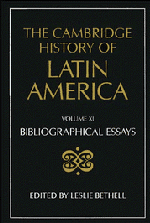Book contents
- Frontmatter
- I THE INDIGENOUS PEOPLES OF MIDDLE AND SOUTH AMERICA ON THE EVE OF THE CONQUEST
- II COLONIAL SPANISH AMERICA
- 1 The Spanish conquest and settlement of America
- 2 Indian societies and the Spanish conquest
- 3 Spain and America in the sixteenth and seventeenth centuries
- 4 Spain and America: The Atlantic trade, 1492–c.1720
- 5 Spain and America in the eighteenth century
- 6 Population
- 7 Urban development
- 8 Mining
- 9 The formation and economic structure of the hacienda in New Spain
- 10 The rural economy and society of Spanish South America
- 11 Aspects of the internal economy: Labour, taxation, distribution and exchange
- 12 Social organization and social change
- 13 Indian societies under Spanish rule
- 14 Africans in Spanish American colonial society
- 15 Women in Spanish American colonial society
- 16 The Catholic church
- 17 Literature and intellectual life
- 18 Architecture and art
- 19 Music
- III COLONIAL BRAZIL
- IV THE INDEPENDENCE OF LATIN AMERICA
- V LATIN AMERICA: ECONOMY, SOCIETY, POLITICS, c. 1820 TO c. 1870
- VI LATIN AMERICA: ECONOMY, SOCIETY, POLITICS, c. 1870 to 1930
- VII LATIN AMERICA: ECONOMY, SOCIETY, POLITICS, 1930 to c. 1990
- VIII IDEAS IN LATIN AMERICA SINCE INDEPENDENCE
- IX LATIN AMERICAN CULTURE SINCE INDEPENDENCE
- X THE INTERNATIONAL RELATIONS OF LATIN AMERICA SINCE INDEPENDENCE
- THE CAMBRIDGE HISTORY OF LATIN AMERICA
12 - Social organization and social change
from II - COLONIAL SPANISH AMERICA
Published online by Cambridge University Press: 28 March 2008
- Frontmatter
- I THE INDIGENOUS PEOPLES OF MIDDLE AND SOUTH AMERICA ON THE EVE OF THE CONQUEST
- II COLONIAL SPANISH AMERICA
- 1 The Spanish conquest and settlement of America
- 2 Indian societies and the Spanish conquest
- 3 Spain and America in the sixteenth and seventeenth centuries
- 4 Spain and America: The Atlantic trade, 1492–c.1720
- 5 Spain and America in the eighteenth century
- 6 Population
- 7 Urban development
- 8 Mining
- 9 The formation and economic structure of the hacienda in New Spain
- 10 The rural economy and society of Spanish South America
- 11 Aspects of the internal economy: Labour, taxation, distribution and exchange
- 12 Social organization and social change
- 13 Indian societies under Spanish rule
- 14 Africans in Spanish American colonial society
- 15 Women in Spanish American colonial society
- 16 The Catholic church
- 17 Literature and intellectual life
- 18 Architecture and art
- 19 Music
- III COLONIAL BRAZIL
- IV THE INDEPENDENCE OF LATIN AMERICA
- V LATIN AMERICA: ECONOMY, SOCIETY, POLITICS, c. 1820 TO c. 1870
- VI LATIN AMERICA: ECONOMY, SOCIETY, POLITICS, c. 1870 to 1930
- VII LATIN AMERICA: ECONOMY, SOCIETY, POLITICS, 1930 to c. 1990
- VIII IDEAS IN LATIN AMERICA SINCE INDEPENDENCE
- IX LATIN AMERICAN CULTURE SINCE INDEPENDENCE
- X THE INTERNATIONAL RELATIONS OF LATIN AMERICA SINCE INDEPENDENCE
- THE CAMBRIDGE HISTORY OF LATIN AMERICA
Summary
Sophisticated discussion of Spanish American social organization is extremely rare. But see by James Lockhart, ‘Encomienda and hacienda: The evolution of the great estate in the Spanish Indies’, HAHR, 49 (1969), 411–29; introduction to Ida Altman and James Lockhart (eds.), Provinces of Early Mexico: Variants of Spanish American Regional Evolution (Los Angeles, 1976); ‘Capital and province, Spaniard and Indian: The example of late sixteenth-century Toluca’, in Altman and Lockhart, Provinces of Early Mexico, 99–123. See also Wbodrow Borah, ‘Race and class in Mexico’, Pacific Historical Review, 23 (1954), 331–42; Enrique Otte, ‘Träger und Formen der wirtschaftlichen Erschliessung Lateinamerikas im 16. Jahrhundert’, JGSWGL, 4 (1967), 226–66; and Richard Boyer, ‘Mexico in the seventeenth century: Transition of a colonial society’, HAHR, 57/3 (1977), 454–78. The latter two articles are perhaps more economic than social in orientation. Two broad thematic works by Magnus Mörner cover all Spanish America for the entire colonial period and are in a part social, part legal vein: Race Mixture in the History of Latin America (Boston, 1967), and La corona española y los foráneos en los pueblos de indios de América (Stockholm, 1970). See also Guillermo Céspedes’s synthesis, Latin America: The Early Years (New York, 1974), summarizing much basic research. James Lockhart and Enrique Otte, Letters and People of the Spanish Indies, Sixteenth Century (Cambridge, Eng., 1976) contains analysis of general social types and processes together with specific examples; Otte’s ‘Die europäischen Siedler und die Probleme der Neuen Welt’, JGSWGL, 6 (1969), 1–40 contains additional similar material.
- Type
- Chapter
- Information
- The Cambridge History of Latin America , pp. 100 - 104Publisher: Cambridge University PressPrint publication year: 1995



